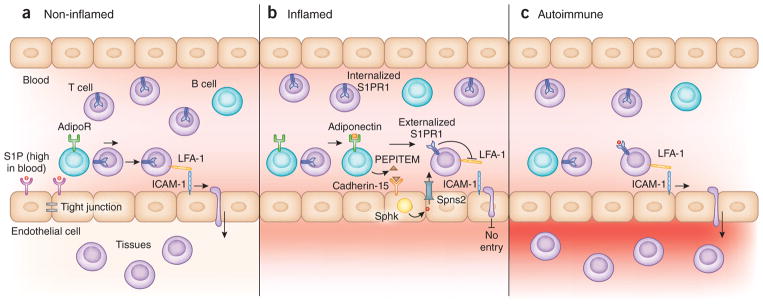Figure 1.
The role of B cells in S1P-mediated regulation of T cell trafficking. (a) In non-inflamed tissues, high S1P concentration in blood results in S1PR1 downregulation on circulating T cells, and interactions between T cell LFA-1 and endothelial cell (EC) ICAM-1 facilitate T cell TEM into non-inflamed tissues. S1P activation of endothelial cell S1PR1 promotes endothelial cell tight junctions, maintaining vascular integrity. (b) Chimen et al.1 show that in inflamed tissues adiponectin stimulates B cells through AdipoRs, inducing them to release PEPITEM. PEPITEM binds to its receptor, cadherin-15, on endothelial cells. Cadherin-15 activation leads to production of S1P by the enzyme sphingosine kinase 1. S1P is exported to the extracellular space through the Spns2 transporter. Adherent T cells stimulated by inflammatory signals upregulate S1PR1, which allows them to bind the S1P released locally from endothelial cells. As a result of S1P signaling, T cell LFA-1 and endothelial cell ICAM-1 are reduced; T endothelial cell TEM is blocked, and inflammation is restrained. (c) In autoimmune tissues, B cells lack adiponectin receptors and thus fail to initiate the adiponectin–PEPITEM axis. Interactions between T cell LFA-1 and endothelial cell ICAM-1 facilitate inappropriate T cell TEM into inflamed tissues, thereby intensifying inflammation.

